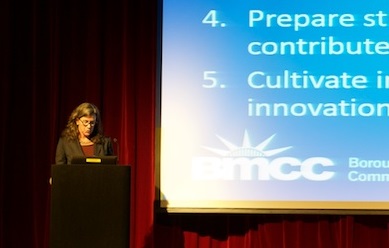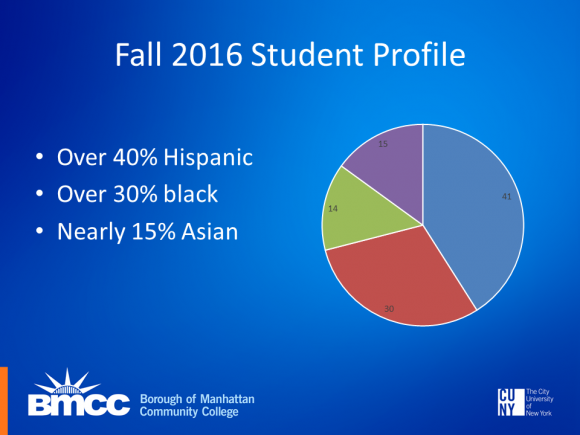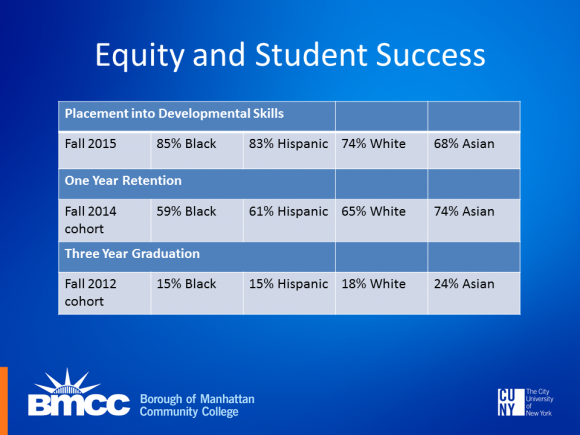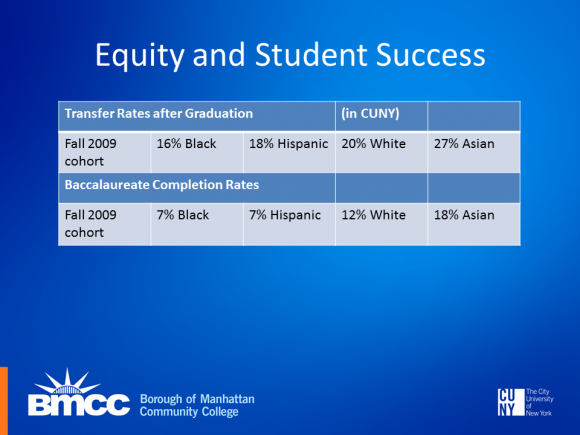Designing for Student Success
Karrin E. Wilks, Senior Vice President & Provost
January 27, 2017
Good morning and welcome to our first annual Faculty Convocation. Thank you all for joining us. We are very pleased to have to have this opportunity for collective conversation about teaching and learning in support of student success. Creating opportunities for faculty dialogue about student success is essential to our goal of improving student success. We can’t possibly do that without a collaborative culture, an intentional design for student success, a culture of inquiry that systematically studies our design for student success, and a design grounded in shared guiding principles and a shared understanding of how we define student success.
So this morning I’d like to talk a little about different lenses through which to view student success, share some guiding principles that are important to me, and pose many questions throughout. I see asking questions and encouraging dialogue as one of my primary roles. Hopefully you will have comments or questions at the end, and we’ll continue our collective conversation throughout the day and the semester.
So what do we mean by student success? As you know, we have a revised mission statement that defines student success in these terms:
– first, broadly, in terms of intellectual and personal growth
– second, more pointedly, in terms of degree completion, successful transfer, career achievement, lifelong learning, and civic participation.
So I ask you in our collective design for success, which of those indicators are most important to you, as a faculty member? How do we design for success in those terms? And what is the role of faculty leadership in realizing the design?

We also have a strategic plan, Reaching Greater Levels: 2015-2020, that defines our institutional effectiveness largely in terms of student success. Grounded in a student progression model that focuses on key transition points in a student’s educational journey from college readiness through graduation and beyond, we have committed ourselves to five strategic priorities aimed at improving student success:
- Strengthen college readiness and improve the effectiveness of developmental offerings, with our sharp focus on curricular and pedagogical innovation in remedial offerings.
- Improve the student experience, with a particular emphasis on improving advisement and student outcomes in gateway courses.
- Facilitate timely degree completion, graduation, and transfer, particularly through scaling successful cohort models like ASAP, the Learning Academy, and Out in Two;
- Prepare students for 21st century careers and contribute to workforce development in NYC with an emphasis on improving the STEM pipeline, and expanding internships and experiential learning, including undergraduate research.
- Cultivate institutional transformation, innovation, and sustainability, particularly through enhanced professional development and by developing the theory and practice of faculty leadership at BMCC.
Again I ask you to consider, which of these priorities is most important to you as a faculty member? How do we design for success in those terms? And what is the role of faculty leadership in realizing the design?
Our mission and our strategic plan offer two critical lenses through which to view student success. A variant and for our deliberation here is to consider success from these perspectives:
What does student success from a teaching/learning perspective, a classroom perspective mean?
What does student success from a student perspective mean?
What does student success from an institutional perspective mean?
What does student success from an equity and social justice perspective mean?
I want to talk about each of these a bit more, but first I want to share some guiding principles that ground my thinking about student success. I invite you to think about your guiding principles, and for us to continue a dialogue about guiding principles as fundamental to designing for student success.
So these are Karrin’s guiding principles for defining and designing for student success. You could also call these fundamental working theories. Either way, this is about developing a collective narrative about where we want to go as a college, about our hopes, dreams, and aspirations for our students.
Students can learn anything under the right conditions. Rather than viewing poor preparation and students’ life circumstances as insurmountable barriers, we are deeply engaged in examining our own practices and developing theories and practice about the right conditions under which all students can learn.
Every student needs direction and connection. This is about the power of academic planning and engagement, and personalization, and knowing there is at least one person looking out for you, at least one person you can always turn to.
Learning outcomes can (and must) improve. There is overwhelming evidence that we can design for improved student success. When colleges have a culture based on student success, faculty and staff consistently invent ways to improve student outcomes. It is possible to move the dial.
The college is what our students experience, not what we think they experience or hope they experience or what we experience, but what students actually experience, every step of their journey. We need to deeply understand their experience, and we need their voices in our design for success.
Access to success—not just access to enrollment— is fundamental to advancing equity, opportunity, and social justice. This is a shift in thinking about institutional success, particularly for community colleges designed as access/enrollment machines. Access is not good enough.
BMCC cannot realize our vision to become a premier community college as defined by student success without strong, visible and pervasive faculty leadership, such that the most effective success practices are recognized and scaled. Put more directly, faculty are the mechanism for scaling success.
So with these guiding principles as a foundation, let’s consider the four lenses through which we could define student success. First:
Defining student success in the classroom: focus on teaching and learning. I’m going to tell two brief stories from my experience as a teacher which symbolize, in simple terms, how I would define student success from a classroom perspective.
The first is from when I taught high school English when I was not much older than some of my students. For context, the high school was heavily tracked so that ninth graders were placed in one of three English classes: thoughtfully labeled 9A, 9B1 and 9B2. As the newest and least-experienced teacher, I was assigned 9B2, obviously the lowest level. Many of the students were mortified that they were placed in the class, including one who repeatedly asked if I could shut the door so she wouldn’t be seen by people walking by. One day an angry student threw a folding chair at me; another time a student revealed through an assignment that she had attempted suicide more than once. I was completely unprepared to manage the teaching and learning in this classroom, to rethink my notions of curriculum and pedagogy and engagement. Students passed the class, but there was a missed opportunity for deep learning, a missed opportunity for student success.
From the opposite side of the spectrum of student success, for many years I taught a freshmen-experience type class called Dimensions of Learning at the Community College of Vermont. One of the readings was Plato’s Allegory of the Cave, and I was frequently intrigued by how engaged my mostly female adult students were during these discussions. One woman in particular, a single mom with a history of struggle and violence, I will always remember when she exclaimed: “This is me, my life, the chains, the shadows, me not willing to see the truth.” She was intellectually and personally excited about her own learning. The point is that the experience in the classroom had a profound effect on how she came to see her life and her place in the world. She passed the class but her success was much more than that, it was about a change in her belief system.
Obviously we want students to pass their courses, but how do we create a culture of student success that goes beyond pass rates, to expand the kind of deep learning that leads to change—in knowledge or behaviors or beliefs or attitudes? Learning that has a lasting impact on how students think or act? Learning that reflects what we believe about what it means to be an educated person. The “intellectual and personal growth” part of our mission statement, the parts about lifelong learning and civic engagement. The part about making the world a better place. How do we most effectively create a culture of student success defined this way?
Moving from defining student success from a teaching and learning perspective, from the classroom: How about defining student success from the students’ perspective?
During this past registration period we asked 499 students to respond to a brief questionnaire that asked about their goals for being at BMCC and how they would define success. Over 50% indicated that getting a degree was their goal (and half of those specified a bachelor’s degree), and 25% said passing their classes was their goal. The majority defined success in terms of getting a degree, passing classes, and achieving their goals. Getting a degree is their definition of success, including successfully transferring to earn a baccalaureate degree. And 44% defined success in terms of a good career. According to a survey conducted annually by the Higher Education Research Institute at UCLA, students are increasingly reporting that they are going to college to get a good job, and choosing colleges whose graduates get good jobs.
This is not to negate the many student responses about becoming a better person and improving the lives of family and others. This is just to say that getting a degree and a good job are fundamental to student definitions of their own success.
So how does that align with how we are defining student success from an institutional perspective? We have explicit strategic plan outcomes, linked to our mission statement, for improving retention and graduation rates, degree completions, and successful transfer. Here is a snapshot of how we are doing overall.

KEY STUDENT OUTCOMES
Our retention rate is stubbornly flat, but the graduation rate is increasing incrementally. The ASAP graduation rate is evidence that student outcomes can improve. In 2016, we conferred 4200 degrees, an all time high. For our transfer students, of our 2015 graduates sixty percent of them went to CUNY colleges, and six percent went to non-CUNY colleges. Our six-year baccalaureate rate for the fall 2010 cohort is seventeen percent for all, and thirty-eight percent for those who complete an associate degree.
We recently did an analysis of factors predictive of three-year graduation at BMCC. Here is what we found:
FACTORS PREDICTIVE OF THREE-YEAR GRADUATION AT BMCC
- being exempt from remediation: the longer you’re in, the less likely you are to persist
- enrollment in ASAP or College Discovery: cohort models work
- passing all first fall semester courses: the importance of success in the first semester
- summer enrollment, particularly before the second fall: credit accumulation, momentum
- being female
- not being black or Hispanic
So let’s remember who are students are:


And…
- 68% full-time, 57% female, average age 24
- First-time freshmen: 77% require remediation, 72% need math, 13% need all three; 15% exempt
- Over 165 foreign birth countries: Dominican Republic, China, Bangladesh, Jamaica, Haiti
- Over 105 languages spoken: Spanish, Chinese, Bengali, French, Russian
- Largest majors: Liberal Arts, Criminal Justice, Business Administration, Undeclared Health, Early Childhood, Business Management, Accounting, Science, Human Services, Computer Sciences
This brings us to thinking about student success from an equity perspective. Here are some data aligned with our strategic planning student progression model.
EQUITY AND STUDENT PROGRESS

Black and Hispanic students are more likely to be placed in developmental courses
Black and Hispanic students have lower one-year retention rates compared to other groups
Black and Hispanic students have lower three-year graduation rates compared to other groups
Black and Hispanic students have lower CUNY transfer rates compared to other students
Black and Hispanic students have lower CUNY 6-year baccalaureate graduation rates compared to other students

It is clear that we need to explicitly address equity gaps at every key transition point in our students’ educational journey with us. This is fundamental to our student progress model as a way of defining student success, and fundamental to our historic mission to advance equity and social justice. I encourage us to think about this as a matter of scholarly inquiry into the pedagogical, curricular, and structural strategies that are effective in reducing performance gaps. Again, we can point to colleges who have been successful in this effort. We can and we must improve performance gaps.
The Center for Urban Education at the University of Southern California talks about this in terms of being equity-minded, and that equity-minded institutions follow certain principles and demonstrate key indicators.
CENTER FOR URBAN EDUCATION: EQUITY-MINDED INSTITUTIONS

Institutionally-Focused: Focus on remediating the institution’s actions rather than students’ actions alone. Equity must be enacted as a pervasive principle.
Critically Race Conscious: Pay attention to whether minoritized groups are participating, feel welcome, and succeed.
Systemically Aware: Recognize and counteract institutional and structural racism and other forms of bias, explicit and implicit. Clarity in language is vital. Having the courage to have hard conversations is critical.
Evidence-Based: Informed by disaggregated data and qualitative inquiry findings. Questioning assumptions, and clarity in goals and measures are vital.
Action-Oriented: Take action to eliminate inequity. Equitable practice and policies are designed to accommodate differences in the contexts of students’ learning, not to treat all students the same. Equity is not the same as equality, a principle we must operationalize.
In thinking about student success from an equity perspective, we must also consider student achievement after they leave us, for which students themselves have two primary goals: successful transfer and a good career. I have shared some data about the work we need to do to reduce performance gaps in transfer and baccalaureate achievement. But what about family-sustaining wages and upward mobility? We know that our graduates’ median annual income steadily rises over time, but on average from a starting rate below $25,000. That is obviously a challenge here in New York City.
The very good news is that BMCC, in alignment with our mission, is a social justice engine from the perspective of upward mobility. In a recent New York Times op-ed piece entitled “America’s Great Working-Class Colleges” based on a massive big data study that measured students’ earnings after leaving college (whether graduating or not), BMCC ranked third nationally of the 690 community colleges in the study, third nationally in the likelihood that a BMCC student will move up two or more income quintiles from where they entered the college. BMCC students have a 41% likelihood of moving up two or more income quintiles as a result of being here. That is a great point of pride for our college, for our faculty, in realizing our social justice mission.
Additionally, Baruch College ranked in the top ten in the same study, as 79% of their students from the bottom fifth of the income distribution end up in the top three-fifths. More BMCC graduates go to Baruch than any other transfer destination, and students who started at BMCC made up around 14% of the most recent graduating class at Baruch, so we can take pride in our essential feeder role in ensuring upward mobility as well, a fundamental social purpose of community colleges.
We have a vision that BMCC will be recognized as one of our nation’s premier community colleges in relation to student success and academic excellence, known as thought leaders in higher education.
So I return to some of my original questions: How do we design for success in those terms? And what is the role of faculty leadership in realizing the design? Let’s consider both design and faculty leadership briefly before I close.
Valencia Community College was the first to win the Aspen Prize for Community College Excellence and is nationally known for their remarkable gains in student outcomes, including closing performance gaps among students of different backgrounds. They have developed and employed a process for collaborative design and innovation that is based on architectural design and involves four steps:
1) Defining the design principles,
2) Developing a schematic theory based on the design principles,
3) Developing the design, and
4) Implementing the design.
The point of this example is that successful colleges collaboratively design for success, a process that begins with dialogue and the collective definition of design principles, and a collective narrative about what student success looks like, inquiry into what’s working and what needs attention— all driving a faculty culture of student success. Designing for success must be disciplined, intentional.
We can’t possibly achieve our vision, we can’t possibly improve student success without strong, visible and pervasive faculty leadership. Through a variety of venues, this Convocation included, we are developing our theory of faculty leadership for student success, faculty leadership in formal and informal roles, within and across departments and disciplines, inside and outside the classroom.
Faculty leadership to make BMCC the kind of organization we want to teach and learn and grow in. A culture that flourishes, as evidenced by continuous learning; a culture that is energized, engaged, generous, compassionate A collaborative culture designed for student success, one that practices and celebrates teaching excellence, the review of evidence, and ongoing experimentation. A culture that respects and embraces the challenges and opportunities related to student success, such that when students don’t succeed, faculty routinely respond with theories of change. Rather than viewing poor preparation and life demands as insurmountable barriers to student success, we deeply engage in analysis of how our own actions can drive stronger outcomes. A culture in which pedagogical leadership is held in the highest esteem.
So I thank you for your contributions, both inside and outside the classroom. I thank you for your commitment to student success and excellent teaching. I thank you for your pedagogical and thought leadership about student success from multiple perspectives: teaching and learning, students’ dreams and goals for themselves, institutional priorities, and advancing equity. This is the work before us, designing a culture of student success.


